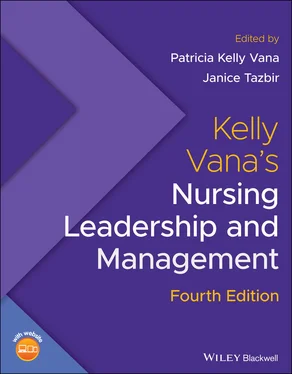41 McDermott, K. W., Elixhauser, A., & Sun, R. (2017). Trends in hospital inpatient stays in the United States, 2005–2014. Healthcare Cost and Utilization Project, AHRQ, Statistical Brief #225.
42 Montag, M. L. (1959). Community college education for nursing. New York: McGraw Hill.
43 Montag, M. L. (1963). Technical education in nursing? The American Journal of Nursing, 63, 100–103.
44 Noyes, C. D. (1912). The midwifery problem. American Journal of Nursing, 12, 466–471.
45 Orsolini‐Hain, L., & Waters, V. (2009). Education evolution: A historical perspective of associate degree nursing. Journal of Nursing Education, 48, 266–271.
46 Richards, L. (1911). Reminiscences of America's first trained nurse. Boston, MA: Whitcomb & Barrows.
47 Robb, W. J. W. (2005). The ABCs of nursing doctoral degrees. Dimensions of Critical Care Nursing, 24(2), 89–96.
48 Schryver, G. F. (1930). A history of the Illinois training school for nurses. Chicago, IL: Illinois Training School.
49 Stafford, M. (2016). Interview for the Anne Zimmerman project. Midwest Nursing History Research Center Archives. University of Illinois at Chicago.
50 Thatcher Ulrich, L. (1991). A midwife's tale: The life of Martha Ballard, based on her diary, 1785‐1812. New York: Random House.
51 Tobbell, D. (2018). Nursing's boundary work. Theory development and the making of nursing science, 1950‐1980. Nursing Research, 67(2), 63–73.
52 Ulrich, C. M., Grady, C., Hamric, A. B., & Berlinger, N. (2016). Nurses at the table: Nursing, ethics, and health policy. Hastings Center Report, 46(S 1), S2. ‐outside back cover
1 Brenan, M. (2018). Nurses again outpace other professions for honesty, ethics. Gallop News. Retrieved from https://news.gallup.com/poll/245597/nurses-again-outpace-professions-honesty-ethics.aspx
2 D'Antonio, P., Connolly, C., Mann Wall, B., Whelan, J., & Fairman, J. (2010). Histories of nursing: The power and the possibilities. Nursing Outlook, 58(4), 207–213.
3 Fairman, J., & D'Antonio, P. (2013). History counts: How history can shape our understanding of health policy. Nursing Outlook, 61, 346–352.
4 Foth, T. (2012). Nurses, medical records and the killing of sick persons before, during, and after the Nazi regime in Germany. Nursing Inquiry, 20(2), 93–100.
5 Lagerwey, M. D. (2010). Ethical vulnerabilities in nursing history: Conflicting loyalties and the patient as "other.". Nursing Ethics, 17, 590–602.
6 Nelson, S., & Gordon, S. (2004). The rhetoric of rupture: Nursing as a practice with a history? Nursing Outlook, 53, 53–54.
7 Pollitt, P. (2018). Nurses fight for the right to vote. American Journal of Nursing, 118(11), 46–54.
8 Price, S. L., & McGillis Hall, L. (2013). The history of nurse imagery and the implications for recruitment: A discussion paper. Journal of Advanced Nursing, 70, 1502–1509.
4 Organization of Patient Care in High Reliability Care Organizations
Patti Ludwig‐Beymer
Purdue University Northwest, College of Nursing, Hammond, IN, USA
 A strong safety culture requires skillful leaders with exceptional communication abilities.
A strong safety culture requires skillful leaders with exceptional communication abilities.
Source: Used with permission from the U.S.A. Government.
A strong safety culture begins with leadership; their behaviors and actions set the bar. I urge all health care leaders to make safety culture a top priority at their health care organization. Establishing and improving safety culture is just as critical as the time and resources devoted to revenue and financial stability, system integration and productivity—because a lack of safety culture can have serious consequences for patients, staff and other stakeholders.
Ana Pujols McKee, MD, Executive Vice President and Chief Medical Officer,
The Joint Commission(TJC, 27 December 2017, para. 6).
Upon completion of this chapter, the reader should be able to:
1 Describe the current state of quality and safety in health care organizations.
2 Define High Reliability within healthcare settings.
3 Evaluate the characteristics of high reliability organizations (HROs).
4 Analyze the impact of Quality and Safety Education for Nurses (QSEN) competencies on high reliability.
5 Discuss nursing's role in high reliability organizations.
6 Identify resources nurse leaders can use to foster a culture of high reliability.
Ms. Smith's daughter Kali is a patient in the Neonatal Intensive Care Unit (ICU). Ms. Smith diligently pumps her breasts to provide nourishment to her newborn. After pumping, Ms. Smith gives the milk to the nurse, who labels it and places it in the refrigerator. The next day, the nurse prepares a feeding for Kali. After administering the feeding, the nurse notices that the milk is labeled with Ms. Brown's name .
By definition, this is a serious safety event. The organization takes immediate action: it notifies both Ms. Smith and Ms. Brown, and tests Ms. Brown for a variety of infectious diseases. In addition, the error is thoroughly investigated by a team that includes nurses, nursing assistants, physicians, and staff from infection prevention, risk management, quality, information technology, and administration. The team conducts a root cause analysis to determine the underlying cause of the breast milk mis‐administration and creates a corrective action plan. The executive leadership team and board of directors review the information and approve the corrective action plan. Everyone at the hospital expresses confidence that the processes put into place will prevent this event from happening again. Unfortunately, within a few months, the incorrect breast milk is administered to a baby in the pediatric department .
The Institute of Medicine(IOM, 1999) described the safety of U.S. health care in To Err is Human . They suggested that 44,000–98,000 people die in hospitals each year from medical errors that could have been prevented and provided a roadmap to safety. The IOM outlined strategies to prevent errors, including enhancing knowledge about safety; identifying and learning from errors; raising expectations for improving safety; and implementing safety systems in health care organizations to ensure safe practices at the patient care delivery level. Seventeen years later, Makary and Daniel (2016) estimated that medical errors cause 251,000 deaths each year. This makes medical errors the third leading cause of death in the Unites States (U.S.) after heart disease and cancer.
Safety is the responsibility of every nurse and each member of the interprofessional team. Despite the heavy focus on quality and safety, errors continue to occur. Nursing managers and leaders are in a unique position to foster a culture of high reliability. This chapter will describe the current state of quality and safety in health care organizations. After defining and evaluating the characteristics of HRO s, the chapter will analyze the impact of QSEN competencies on high reliability. Last, the chapter will describe the role of the nurse in creating a culture of safety and identify resources nurse leaders can use in a journey toward high reliability.
Health care is dangerous, and mistakes or errors can have devastating consequences for patients and staff. Nurses and other health care professionals do not come to work intending to harm patients. However, humans make mistakes. It is part of the nature of being human. Most medical errors do not result from individual recklessness. Instead, many medical errors are caused by faulty health care systems, processes, and conditions that lead people to make mistakes or fail to prevent them. This means that health systems can best prevent mistakes by creating processes that make it easier to do the right thing and harder to do the incorrect thing.
Читать дальше

 A strong safety culture requires skillful leaders with exceptional communication abilities.
A strong safety culture requires skillful leaders with exceptional communication abilities.










